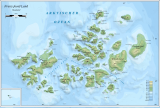Wiener-Neustadt-Insel
| Wiener-Neustadt-Insel | ||
|---|---|---|
 | ||
| Gewässer | Arktischer Ozean | |
| Inselgruppe | Franz-Josef-Land | |
| Geographische Lage | 80° 48′ N, 58° 24′ O | |
| Länge | 22 km | |
| Breite | 16 km | |
| Fläche | 237 km² | |
| Höchste Erhebung | Peak Parnass 620 m | |
| Einwohner | unbewohnt | |
 | ||
Die Wiener-Neustadt-Insel (russisch Остров Винер-Нейштадт, Ostrow Winer-Njoischtadt[1], auch Остров Винер-Нойштадт, Ostrow Winer-Noischtadt)[2] ist eine Insel im Franz-Josef-Land, Russische Föderation.
Die Wiener-Neustadt-Insel hat eine Fläche von 237 km² und ist fast zur Gänze vergletschert. Der höchste Punkt der Insel ist mit 620 m der Peak Parnass, die höchste Erhebung in Franz-Josef-Land.
Die Insel ist Teil der Untergruppe Zichy-Land des Franz-Josef-Archipels. Es ist von der Ziegler-Insel und der Salisbury-Insel durch die schmale Collinson-Meerenge (Proliw Kollinsona) getrennt.
Die Insel wurde von der Österreichisch-Ungarischen Nordpolexpedition unter Julius Payer und Carl Weyprecht nach der südlich von Wien gelegenen Stadt Wiener Neustadt benannt, deren Theresianische Militärakademie Payer absolviert hatte.[3]
Weblinks
- Andreas Umbreit: Wiener Neustadt (Viner-Neyshtadt) Insel – Franz-Joseph-Land (Memento vom 29. Januar 2021 im Internet Archive)
Einzelnachweise
- ↑ Geography of the City of Arkhangelsk – Offizielle Website der Stadt Archangelsk (russisch)
- ↑ Geography of Russia, letter Ф (russisch)
- ↑ Julius Payer: Die österreichisch-ungarische Nordpol-Expedition in den Jahren 1872 - 1874. Hölder, Wien 1876, S. 297 (mdz-nbn-resolving.de).
Auf dieser Seite verwendete Medien
Autor/Urheber: User:Mysid, Lizenz: CC BY-SA 3.0
Map of central Franz Josef Land
Autor/Urheber: Nzeemin, Lizenz: CC BY-SA 3.0
Физическая карта -- Земля Франца-Иосифа, Россия.
- Проекция: Lambert Azimuthal Equal-Area
- Longitude and latitude of the projection center: 55 / 80.8
- Инструменты: GMT
Autor/Urheber: Oona Räisänen (übersetzt durch Thariama), Lizenz: CC BY 3.0
Karte des russischen Franz-Josef-Land.
Autor/Urheber: NASA's Earth Observatory, Lizenz: CC BY 2.0
To download the full resolution and other files go to: earthobservatory.nasa.gov/IOTD/view.php?id=76883&src=...
Located just 600 miles (970 kilometers) from the North Pole, Franz Josef Land is perpetually coated with ice. Glaciers cover roughly 85 percent of the archipelago’s land masses, and sea ice floats in the channels between islands even in the summertime.
The Advanced Spaceborne Thermal Emission and Reflection Radiometer (ASTER) on NASA’s Terra satellite observed the islands of central Franz Josef Land on August 16 and 19, 2011. (Another sensor on Terra captured a wider view on August 17, 2011.)
The image above was made from a combination of visible and near-infrared wavelengths, and ice appears in shades of white and pale blue. The amount of sea ice filling the channels between the islands of Franz Josef Land varies from summer to summer. Captured toward the end of the Northern Hemisphere melt season, this shot shows a modest amount of sea ice on the ocean surface. Some of the ice has accumulated in bays like the one near northeastern Zieger Island.
Most of the ice in this scene is anchored to land, as large glaciers blanket the islands. Yet today’s glaciers are tiny compared to the ice sheet that dominated the region about 20,000 years ago. Studies of Franz Josef Land have actually contributed to a larger understanding of when that massive ice sheet began its slow retreat. Raised beaches, which preserve evidence of land rising as the crushing weight of overlying glaciers eases (known as isostatic rebound), were first recognized on the islands in the late nineteenth century. Researchers estimate that the giant ice sheet had retreated by about 10,000 years ago.
NASA image created by Jesse Allen, using data provided courtesy of NASA/GSFC/METI/ERSDAC/JAROS, and U.S./Japan ASTER Science Team. Caption by Michon Scott with information from Walt Meier and Ted Scambos, National Snow and Ice Data Center.
The Earth Observatory's mission is to share with the public the images, stories, and discoveries about climate and the environment that emerge from NASA research, including its satellite missions, in-the-field research, and climate models.
Like us on Facebook
Follow us on Twitter
Add us to your circles on Google+




